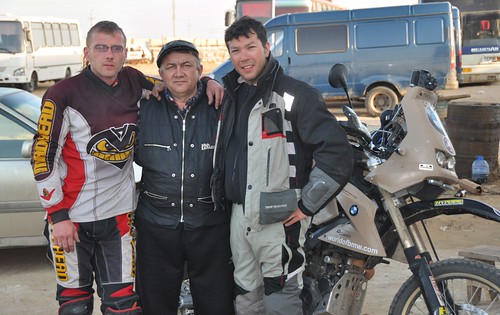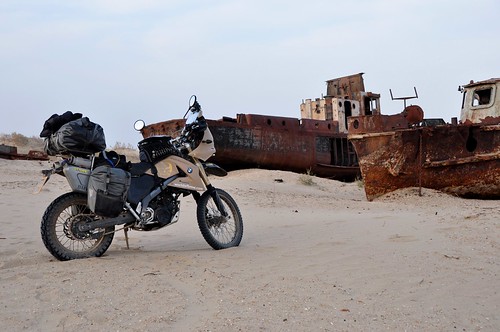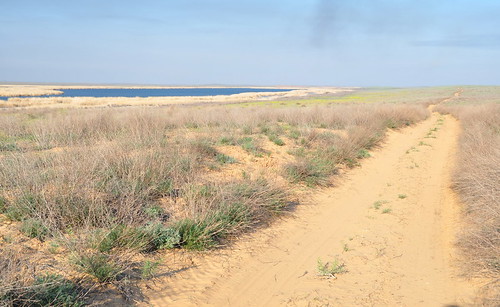26.04.09, late at night … Elista, Kalmykia

Today began with my repeating several times to Shamil, my host in Terekli Mekteb that I only had time to do two things today before hitting the road. (1) was to see ‘Mama Rosa’ the mother of Abrek and Irina from Cherkessk, as I had promised and (2) was to go to a metal worker and do some minor repairs to one of my saddle bags. I was aware of the way the Nogai hospitality worked. Both in Cherkessk and now in Terekli Mekteb, there was a tendency to impose a schedule and a plan onto the guest. I had been frustrated by Akhmed in Cherkessk for not listening to or attending to the few things I needed to do, but instead doing what he wanted us to do, and I hoped that could be avoided in Terekli Mekteb by repeatedly saying that I needed to be on the road by 11 am, I had a 8 hour ride to Elista ahead and I only had time to do 2 things in the morning.
 Unfortunately, it didn’t work out that way. It was 11am by the time Zaur, the military commander of the region arrived in his land cruiser to drive us around. But instead of driving us around to sort the panniers, and despite having had breakfast an hour earlier, we all sat down for more tea and food and chat. When we finally got moving, we didnt go to visit Mama Rosa, but instead went to visit a friend who worked with hides. They wanted to show me what happens to all the sheep hides and offered me a sheepskin for the bike. Then we eventually made it to Mama Rosa’s place about 12:30pm.
Unfortunately, it didn’t work out that way. It was 11am by the time Zaur, the military commander of the region arrived in his land cruiser to drive us around. But instead of driving us around to sort the panniers, and despite having had breakfast an hour earlier, we all sat down for more tea and food and chat. When we finally got moving, we didnt go to visit Mama Rosa, but instead went to visit a friend who worked with hides. They wanted to show me what happens to all the sheep hides and offered me a sheepskin for the bike. Then we eventually made it to Mama Rosa’s place about 12:30pm.
 Next I thought we were going to get my bags fixed at the towns master metal worker, one of the guys who was with us yesterday and had promised to fix the bags first thing Sunday morning, But instead, we hit the road and went to the cowboy town on Kunbatar, as I had mentioned it was on my route. All my gear had been thrown into the back of the jeep and I was just wearing my jeans and sneakers as I thought we were riding around town getting my tasks done. I stopped 5km out of town and waited for the land cruiser to return … ‘Where are we going?’ I asked … ‘we are supposed to be getting my baggage fixed.’
Next I thought we were going to get my bags fixed at the towns master metal worker, one of the guys who was with us yesterday and had promised to fix the bags first thing Sunday morning, But instead, we hit the road and went to the cowboy town on Kunbatar, as I had mentioned it was on my route. All my gear had been thrown into the back of the jeep and I was just wearing my jeans and sneakers as I thought we were riding around town getting my tasks done. I stopped 5km out of town and waited for the land cruiser to return … ‘Where are we going?’ I asked … ‘we are supposed to be getting my baggage fixed.’
‘No time for that, we will do it in Kunbatar’ was the reply.
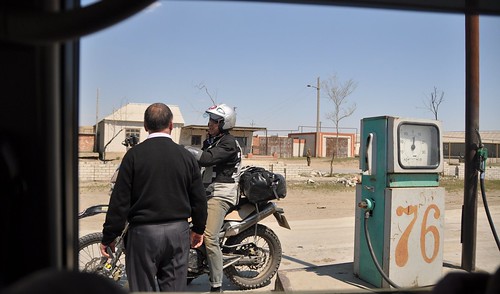 We got to Kunbatar, with me following a jeep load of senior guys from Terekli Mekteb down a dusty dirt track, with most of my riding gear and all my baggage in the back of their land cruiser. We asked around for a metal worked but of course in a one horse cowboy town there was none. It was only 30 km from Terekli Mekteb and anyone with anything to do just went to Terekli.
We got to Kunbatar, with me following a jeep load of senior guys from Terekli Mekteb down a dusty dirt track, with most of my riding gear and all my baggage in the back of their land cruiser. We asked around for a metal worked but of course in a one horse cowboy town there was none. It was only 30 km from Terekli Mekteb and anyone with anything to do just went to Terekli.
We settled on a house where a guy said he had a son who could fix anything. OK… So the guys gets out a primitive drill and prepares to drill through my whole bag on his veranda. I stopped him and made it clear that its only the metal support rail and plastic rail that need to be drilled. I left him with it while I sorted out all my baggage from the back of the jeep and got dressed into riding gear. All he had to do was drill one hole and put a bolt through it.
In my full riding hit, it was now pretty damn hot in the steppe sun. Temperatures were probably around 15 degrees, but the sun and the 4 layers I had on made it hot. Once I was dressed I went to check the repair work on the sick side bag. I don’t know what the guy had done, but whatever it was it didn’t look right. I obviously wanted a proper job, but I wasn’t paying for it so how do I complain?? I looked at Nikita, one of the guys in the Land cruiser party and the towns I.T. guy (meaning he spoke a tiny bit of English) and screwed up my face as if to say ‘what the hell is this?’. He looked back at me shrugged his shoulders and said ‘don’t worry, he says its fixed OK’.
 What could I do? I took the bag back, packed it up, and loaded up the bike. Why had we not gone to Adjo, Terekli’s metal worker, and had a proper job done? Getting the job done out by a cowboy out in the boonies is surely no quicker than getting the job done properly in a workshop in town. Instead of me saddling up and riding out of there, our posse of 6 guys was now invited into the house for tea and food. I politely declined and said I had to hit the road, but was told, ‘please, its our tradition – to thank them for the repair work.’
What could I do? I took the bag back, packed it up, and loaded up the bike. Why had we not gone to Adjo, Terekli’s metal worker, and had a proper job done? Getting the job done out by a cowboy out in the boonies is surely no quicker than getting the job done properly in a workshop in town. Instead of me saddling up and riding out of there, our posse of 6 guys was now invited into the house for tea and food. I politely declined and said I had to hit the road, but was told, ‘please, its our tradition – to thank them for the repair work.’
I sighed and reluctantly went in for more tea and food. After 30 minutes, facing more hints of staying longer, I just stood up and prepared to go, saying thank yous as I left. It was now 3pm. I had a dodgy bag repair and 8 hours ahead of me on roads that I had chosen because they would be “interesting”. It was a bit of a frustrating end to my time with Nogai people .. a people I had developed a real soft spot for. For the second time I actually left people I like feeling relieved that I was leaving. Sweet, sweet freedom. Hospitality is great, but nothing beats freedom. I guess thats why I love this motorcycle travel thing.
 The landcruiser led me to the dusty edge of Kunbatar and ahead was just a couple of wheel ruts heading north across the steppe. I said my farewells to a quality bunch of guys but needed the freedom that the steppe ruts promised me. I sped off without looking back.
The landcruiser led me to the dusty edge of Kunbatar and ahead was just a couple of wheel ruts heading north across the steppe. I said my farewells to a quality bunch of guys but needed the freedom that the steppe ruts promised me. I sped off without looking back.
It was 40km across nothingness to the next habited place, Yuzhno-Sukhokumsk. I flew across the ground in quick time, following the compass and instinct when the tracks divided. It was a great fun road and my spirits were lifted by focussing on riding instead of the frustrating day I had had prior to saddling up. I stopped on the outskirts of Yuzhno-Sukhokumsk, as i found an asphalt road, but one so bad that everyone, myself included, obviously preferred the dusty sandy tracks at the side of the road rather than the road itself. When i stopped, I saw was I was half expecting to see (but perhaps not so soon), the repair work on the side bag had completely come undone. With the benefit of zip ties, I did a patch job by the side of the dusty track. One way or another I would be in Elista tomorrow and get it fixed properly.
Yuzhno-Sukhokumsk was probably the grimmest town I have passed through on this trip so far. On the North-West frontier of Dagestan, it was the sort of town that everyone wants to leave. At least there was a decent road heading out of town. The steppe around here was so flat that any building was visible 20 km or more before you got there, silhouetted against the horizon. I left Dagestan and re-entered Stavropol Region. The sun was getting lower now and in a town called Turksad I stopped to check directions to the dam that separated Stavropol Region form Kalmykia. While there I noticed that I needed further repairs on my dodgy baggage if I was to get to Elista. While at the petrol station doing my repairs and chatting to the Russian woman behind the counter, a group of Dargin locals came in and began hassling me. The Dargin are another group common in Dagestan. Turksad seemed to have a decent sized Dargin population. Eventually the Russian lady yelled abuse at them and they left. I asked the Russian lady, who had been very civil, are all the locals here like that? She was originally from Moldova but came here to marry her husband 18 years ago. ‘The Russians are fine’ she said, ‘but the Dargins are a real problem’. I had kinda already seen that.
The road from Turksad to the dam was marked as a decent road on my Russian road atlas but was in fact another 2 wheel rut track. It was 40km of potential fun before entering Kalmykia, but the fun I had on that track was tempered by having to stop every 10 km to do more zip tie repair work on my ailing baggage.
Since Bulgaria, when the first part of my baggage broke on my simple fall crossing the railway tracks, i have realised that my hope of doing this trip with the ultralight bicycle luggage was in fact too optimistic. The plastic attachments are simply not durable enough to deal with the stresses of motorcycle travel (and falls). As it happens, I also have a set of Ortlieb motorcycle luggage at home and will get that sent out to me with Tony, when I meet him in Siberia in about 5 weeks time. The bicycle luggage only needs to hold up till then.
 The sun went down during my ride to the isolated, deserted dam, and by the time I got there it was almost dark. I expected a concrete road across the 10km long dam, but instead there was a rutted dirt track. It was a challenge in the near darkness, but there was no point stopping here in the middle of the steppe. I could camp, but I didnt trust the water here. 2/3 of the way across the dam I came across a lonely checkpoint with a chain across the track. This was the Kalmyk border and I shut the bike down and had a chat with the 2 Kalmyk police in the tiny hut. Not surprisingly, I was the only foreigner they had ever seen there.
The sun went down during my ride to the isolated, deserted dam, and by the time I got there it was almost dark. I expected a concrete road across the 10km long dam, but instead there was a rutted dirt track. It was a challenge in the near darkness, but there was no point stopping here in the middle of the steppe. I could camp, but I didnt trust the water here. 2/3 of the way across the dam I came across a lonely checkpoint with a chain across the track. This was the Kalmyk border and I shut the bike down and had a chat with the 2 Kalmyk police in the tiny hut. Not surprisingly, I was the only foreigner they had ever seen there.
If the Nogai have one of the most interesting histories in the region, then the Kalmyk’s have one of the most bizarre – and fascinating.
Like many of the people in the region, the Kalmyk story starts in Mongolia. However, unlike most, the story does not start with Genghis Khan. The Kalmyks began as a Mongolian group called the Oirat, who like many groups originating in Mongolia, (such as Attila’s Hun and Genghis’ Mongols) headed west in search of bounty and new grasslands, the Kalmyks doing so around the 1600s. The Kalmyk were known as a very warlike people (as most conquering hordes usually have to be) and took northern Kazakhstan before moving in on the original Nogai homeland around Astrakhan. By 1700, the Kalmyks had pushed the Nogai south into what is now Dagestan and established a Kalmyk homeland on the Steppe area around their capital Elista. Unlike many of the other Mongolic groups that have swept through this area, the Kalmyks have not mingled with turkic Kipchaks and other steppe nomads, but have remained remarkably ethnically pure. I recall reading that the Kalmyks are the closest genetically to the Mongols of all people, including the Buryats just to the North of Mongolia.
Back to the story …and back on the road, and I stopped in the village of Iki-Burul about 9pm to grab a few litres of petrol. They didn’t have the grade I wanted so I just grabbed enough 93 octane to get me to Elista. I would happily have stopped for the night there too, but there were no hotels, and my efforts to fish for a bed for the night by putting my puppy dog face on and asking the locals if they knew anywhere to stay for the night didn’t work. I was unanimously told to head for Elista where I would find hotels. I met 3 more police in Iki-Burul, and to my surprise 2 of them spoke pretty good English.
I arrived in Elista about 10:30pm … still shaking my head at not being able to hit the road till 3pm. I had the name of a modern hotel in the centre of Elista, and though it would cost me EUR 50 a night, I decided I deserved it. And besides, my accommodation bill since arriving in Russia had been a paltry 15 EUR … 8 EUR for the hotel in Elbrus and 7 EUR for one in Kammenomostsky. The rest had been gratis.
– – –
27.04.2009, Elista
 I awoke in Elista’s finest hotel keen to get the bikes baggage sorted, see the sights of Elista, and get some internet time to update the blog, edit the photos pay some bills etc etc etc. I emptied out the side bags, stuck them on the bike and rode the 3 blocks to the very centre of town. Elista looks like a part of Asia but with a clear sky background that could be the US Midwest or Australian outback. Its bizarre.
I awoke in Elista’s finest hotel keen to get the bikes baggage sorted, see the sights of Elista, and get some internet time to update the blog, edit the photos pay some bills etc etc etc. I emptied out the side bags, stuck them on the bike and rode the 3 blocks to the very centre of town. Elista looks like a part of Asia but with a clear sky background that could be the US Midwest or Australian outback. Its bizarre.  The post communist architecture definitely has a touch of Buddha’s influence about it. I wanted to get some footage of people spinning a prayer wheel in the centre of town, but everyone became shy when I was up there with camera, so I approached a bunch of students and asked them if they would volunteer and turn the wheels as a favour.
The post communist architecture definitely has a touch of Buddha’s influence about it. I wanted to get some footage of people spinning a prayer wheel in the centre of town, but everyone became shy when I was up there with camera, so I approached a bunch of students and asked them if they would volunteer and turn the wheels as a favour.
They were a bunch of 5 university students around 20 years old, led by Sasha (a Kalmyk), with 4 girlfriends in tow (3 Kalmyks and one Kazakh) … actually I think one was his girlfriend and the others classmates. We chatted for a while and then they decided to skip their english class and show me the Hurul, Elista’s main Buddhist temple, and the largest in Europe. Quite an amazing sight, this brightly coloured temple in the middle of this steppe city. 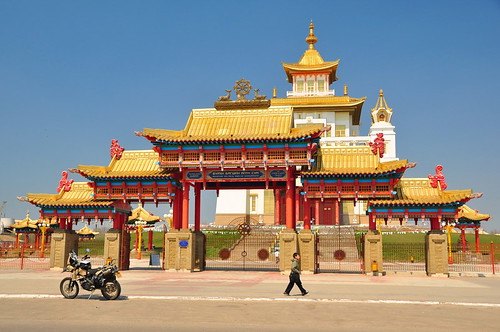 The Dalai Lama was here 2 years ago, but future visits are less likely. The Chinese have been pressuring the Russians not to give him a visa anymore. The Russians have huge commercial interests in China going forward (Russia being one of the largest suppliers of oil, gas,and raw materials in the world and China being the biggest consumer), and weighing up giving the Dalai a visa or keeping the Chinese happy its pretty clear which side they will come down on.
The Dalai Lama was here 2 years ago, but future visits are less likely. The Chinese have been pressuring the Russians not to give him a visa anymore. The Russians have huge commercial interests in China going forward (Russia being one of the largest suppliers of oil, gas,and raw materials in the world and China being the biggest consumer), and weighing up giving the Dalai a visa or keeping the Chinese happy its pretty clear which side they will come down on.
 I will put more photos of the students and other faces around Elista in the photos section.
I will put more photos of the students and other faces around Elista in the photos section.
I had to sort out my bags and Sasha made a few phone calls. He told me to go to Elista Lada, a Lada workshop just down the road. I rode in and a guy waved me over. Turns out he was a biker. Zhenya took me into the worlshop, I explained what I needed done and he began doing it. Professional, proper tools, job done on the side bags. Of course there was no payment wanted for the hour or so he put into it, but instead he asked me to join him and some other bikers in Elista this evening. I am looking forward to that.
 Having mentioned how the Kalmyks got to Europe earlier, I might as well follow up with a bit more modern history. Lenin himself was part Kalmyk … one of his grandmothers was a Kalmychka. You might think this would give the Kalmyks a special place in the Soviet heirarchy, but no. During the second world war, Stalin suspected the Kalmyks of collaborating with the Germans as they advanced across the Steppe towards the oilfields of Chechnya and decided to exile the lot of them to Siberia – Ethnic cleansing if ever it existed. Up to a half of Kalmyks are thought to have died during the transportation by cattle wagon, from starvation or from cold, and it wasn’t till Stalin died that Khruschev permitted them to return to Kalmykia. The date the order to exile to Kalmyks was signed (and to liquidate the Kalmyk Republic), 28th December (1943), is the now the most solemn date in the Kalmyk calendar.
Having mentioned how the Kalmyks got to Europe earlier, I might as well follow up with a bit more modern history. Lenin himself was part Kalmyk … one of his grandmothers was a Kalmychka. You might think this would give the Kalmyks a special place in the Soviet heirarchy, but no. During the second world war, Stalin suspected the Kalmyks of collaborating with the Germans as they advanced across the Steppe towards the oilfields of Chechnya and decided to exile the lot of them to Siberia – Ethnic cleansing if ever it existed. Up to a half of Kalmyks are thought to have died during the transportation by cattle wagon, from starvation or from cold, and it wasn’t till Stalin died that Khruschev permitted them to return to Kalmykia. The date the order to exile to Kalmyks was signed (and to liquidate the Kalmyk Republic), 28th December (1943), is the now the most solemn date in the Kalmyk calendar.
The Kalmyk Republic is the only Buddhist region in Europe and its president is a former very highly ranked international chess player, who loves holding major international chess tournaments in Elista – the middle of nowhere. 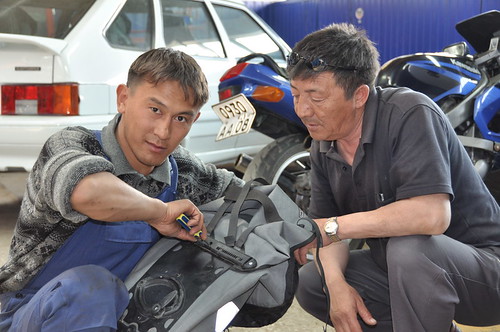 Perhaps as a result of having a strategic thinking president, the Kalmyks seems very well educated and what I have seen of Elista is a notable step forward in terms of modernity compared with surrounding regions – and its considerably cleaner too. The President will have his hands full tho building the Kalmyk economy – Kalmykia is 100% steppe, with very little in the way of natural resources and its small population (less than 1 million) is hardly enough to encourage economies of scale.
Perhaps as a result of having a strategic thinking president, the Kalmyks seems very well educated and what I have seen of Elista is a notable step forward in terms of modernity compared with surrounding regions – and its considerably cleaner too. The President will have his hands full tho building the Kalmyk economy – Kalmykia is 100% steppe, with very little in the way of natural resources and its small population (less than 1 million) is hardly enough to encourage economies of scale.
– – –
Zhenya came round to the hotel at 8pm with a couple of other bikers, and we headed off to their meeting place, a quiet spot just off the main road on the western edge of town. The others had all eaten but I hadn’t, so immediately we zoomed thru town (there is only one main road) to the eastern edge of town and a shashlik cafe called Sem-Ya. These guys were the first bikers I had met since Crimea. Bikes were mostly sports bikes with a couple of Japanese cruiser bikes in there too. Adventure bikes are not really popular in Russia, tho the head honcho of the club had a bizarre beaten up old Tenere, that had been lowered and decked out so that it resembled a cross between a Tenere and a chopper.
The Kalmyks have their own version of tea … Kalmyk Chai or Khan Chai … Khan refering to Ogodei Khan, Genghis’ suc cessor. This was the tastiest variation on tea I had tried so far on the trip. Recommended ! There is a fair bit of Genghis memorabilia about. Traditional Kalmyk leather wallets I saw in a souvenir shop have a portrait of Genghis stamped into them. I am a bit of an afficionado of all things Genghis, but am surprised to see the Kalmyks identifying so closely with the great man. It seems depite leaving Mongolia a long time ago, the Kalmyks are still proud of their Mongol heritage and very much identify with it.
cessor. This was the tastiest variation on tea I had tried so far on the trip. Recommended ! There is a fair bit of Genghis memorabilia about. Traditional Kalmyk leather wallets I saw in a souvenir shop have a portrait of Genghis stamped into them. I am a bit of an afficionado of all things Genghis, but am surprised to see the Kalmyks identifying so closely with the great man. It seems depite leaving Mongolia a long time ago, the Kalmyks are still proud of their Mongol heritage and very much identify with it.
The Nogai seem to have a ambiguous relationship with their Mongol roots. The Nogai guys I met insisted they are only 5% Mongol blood and 95% Kipchak … but watching video clips of Nogai singers, singing Nogai songs, and the overwhelming background of the filmclips were taken from movies or documentaries of Genghis Khan. They love the image the mongol’s convey, but seem to not be comfortable admitting they have mongol ancestry. I found that a bit strange. The Kalmyks have no such ambiguity.
 Max had insisted on a strict schedule. Three alarms went off around 5:30 as we prepared for a big day on the road. Our Kungrad host brought us breakfast and bottled water as we prepped the 3 BMWs in his dusty “back yard”. By 7:45 we were on the road. By 9am we had left Karakapakia and entered Khwarezm. Khwarezm is the lush green oversized oasis created by the Amu Darya river splintering into a bunch of different branches that over centuries have acted as irrigation canals. This Oasis in the desert is 300 km long and 100 km wide and is densely populated with several large cities crammed into it. Its also green. I hadnt seen grass or trees since the Ural river and Atyrau 1000 km ago. It made a nice change and a refreshing burst of colour to see rice paddies, poplar trees lining the highway, as they do so often in central asia
Max had insisted on a strict schedule. Three alarms went off around 5:30 as we prepared for a big day on the road. Our Kungrad host brought us breakfast and bottled water as we prepped the 3 BMWs in his dusty “back yard”. By 7:45 we were on the road. By 9am we had left Karakapakia and entered Khwarezm. Khwarezm is the lush green oversized oasis created by the Amu Darya river splintering into a bunch of different branches that over centuries have acted as irrigation canals. This Oasis in the desert is 300 km long and 100 km wide and is densely populated with several large cities crammed into it. Its also green. I hadnt seen grass or trees since the Ural river and Atyrau 1000 km ago. It made a nice change and a refreshing burst of colour to see rice paddies, poplar trees lining the highway, as they do so often in central asia Khwarezm also plays a key part in the whole Genghis Khan story, that this trip (and frankly any trip to Central Asia) bumps into again and again. It was the then Shah of Khwarezm that brought Genghis into Central Asia. In those days Khwarezm was an enormous empire, covering most of central asia and much of Iran as well. It was one of the richest Muslim states in a time when the muslims and Chinese were really the only “wealthy” or even “educated”people on earth. The Shah didnt so much as ask Genghis to pop by next time he was in the area; rather he captured a Mongol trade caravan and then executed the 3 ambassadors Genghis had personally selected and sent to investigate the seizure. Genghis responded as only he knew how, and took on an army over twice the size of the Mongols’ 100,000 strong force.
Khwarezm also plays a key part in the whole Genghis Khan story, that this trip (and frankly any trip to Central Asia) bumps into again and again. It was the then Shah of Khwarezm that brought Genghis into Central Asia. In those days Khwarezm was an enormous empire, covering most of central asia and much of Iran as well. It was one of the richest Muslim states in a time when the muslims and Chinese were really the only “wealthy” or even “educated”people on earth. The Shah didnt so much as ask Genghis to pop by next time he was in the area; rather he captured a Mongol trade caravan and then executed the 3 ambassadors Genghis had personally selected and sent to investigate the seizure. Genghis responded as only he knew how, and took on an army over twice the size of the Mongols’ 100,000 strong force. You can guess who won … Genghis Khan is a household name, but the Shah of Khwarezm is not, and he died a hunted man, from exhaustion and cold on a nameless Caspian sea Island, after he had earlier fled to Urgench (now todays Konye-urgench).
You can guess who won … Genghis Khan is a household name, but the Shah of Khwarezm is not, and he died a hunted man, from exhaustion and cold on a nameless Caspian sea Island, after he had earlier fled to Urgench (now todays Konye-urgench).


